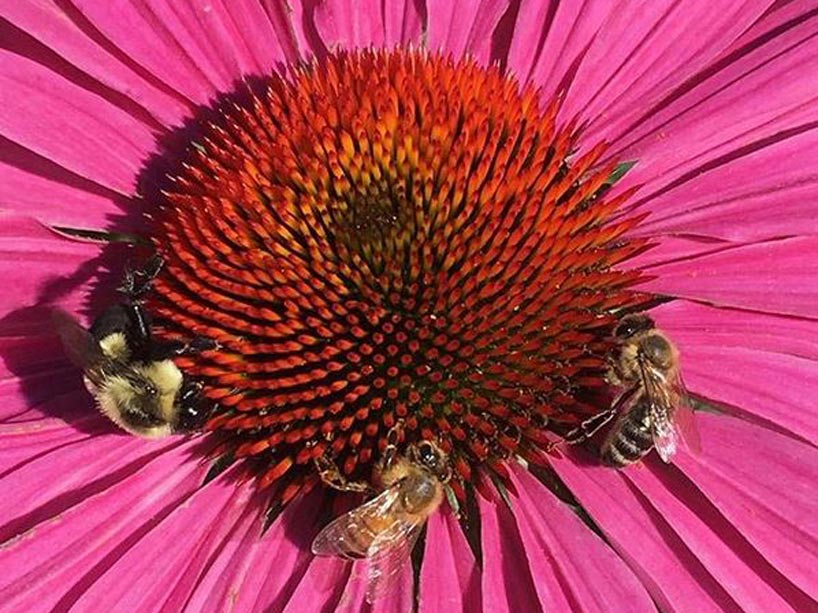The buzz on Ryerson bees

Fun fact: Each of Ryerson Urban Farm’s three beehives can host about 50,000 bees. But each adult bee produces less than one teaspoon of honey in its lifetime.
Along with its crops and seedlings, Ryerson Urban Farm also maintains three beehives, with the assistance of urban beekeepers, Alvéole (external link) . As the spring season begins, Ryerson Today spoke with urban farm manager Arlene Throness and Alvéole’s Madison Weir about what’s buzzing with Ryerson’s bees.
How long has Ryerson had bees?
We are entering our third season with bees. We got our first two hives in 2017 and a third hive in 2018. So we currently have three hives on the Andrew and Pringle Environmental Green Roof on the George Vari Engineering and Computing Centre.
How do you take care of the bees?
With the help of beekeeping company Alvéole, we start checking the hives in April and perform hive checks regularly until October, about every two weeks. At the end of the season, we harvest the honey, leaving enough in the hives for bees to overwinter. Lastly, we check for pests and disease and insulate the hives to ensure that the bees will survive through the winter months.
Why does Ryerson have bees?
Honey bees play an important role at the Ryerson Urban Farm in pollinating our rooftop crops, and the honey is a nice addition to our harvest. There are many other pollinators in our ecosystem, including wild bees, wasps, butterflies, moths, bats, hummingbirds, flies and beetles. We plant wildflowers throughout the season and allow certain weeds to bloom in order to attract and support a healthy community of pollinators and beneficial insects on the rooftop farm.
What is the lifecycle of the bees?
A honeybee colony is made up of thousands of individual worker bees and drones with a single queen. While a queen bee can live for several years, worker bees (who are all female) will only live 30 to 45 days in the spring and summer months, living a bit longer in the winter, and no drones (male bees) even make it until the winter. The queen keeps laying eggs all year long to replace the bees that die off, much like our bodies replace cells as they deteriorate. So while individual bees do not live very long, a colony can survive for a decade, even longer.
How do the seasons affect the hives?
In the spring when the first flowers bloom – which are sugar maple blossoms here in Ontario – worker bees will go out in search of pollen and nectar.
The queen will increase the rate at which she lays eggs (up to 2,000 a day in peak season) to increase the colony size from a small cluster of 5,000 bees that survived the winter to its peak population of 50,000 at the height of the summer. Other worker bees will take care of jobs within the hive, cleaning out any moisture and repairing any wax comb.
As the queen lays the eggs, the younger worker bees will care for the larvae: they will feed them a mix of pollen and royal jelly and keep the larvae at the optimal temperature. The main goal of a colony in the spring is to increase the population size so they are able to take advantage of the summer and produce as much honey as they can as well as reproduce.
In the summer, the bees are busy making honey and storing it for the winter months. They will also create the wax that they use to store and contain the honey in the hive.
Once fall comes, the queen slows down her laying to reduce the size of the colony. The bees begin to form a cluster when the temperature dips below 10 degrees Celsius. They vibrate their wing muscles to generate heat and keep themselves and the queen warm.
In the winter months, it is normal for many bees to die. During warm days, the worker bees will carry the dead bees out of the hive to keep the hive clean and disease-free. This can look a tad gruesome as there is often a pile of dead bees outside the hive entrance in the spring, but it is completely normal. In fact, it is a sign of a healthy hive to see this because they have enough energy and resources to keep their hive clean.
Learn more about the Ryerson Urban Farm.